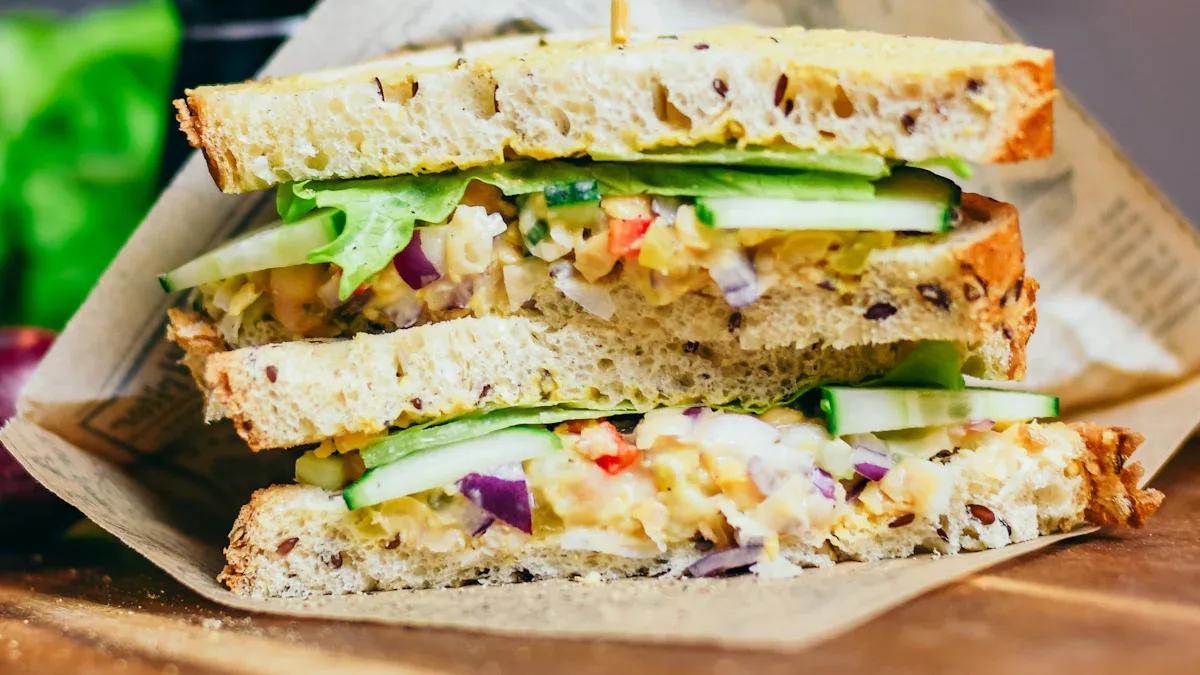
A sandwich maker transforms simple ingredients into gourmet delights. It toasts bread evenly, seals in flavors, and creates a satisfying crunch. With minimal effort, anyone can craft sandwiches that rival restaurant quality. By mastering a few techniques, home cooks can elevate their meals and enjoy perfectly toasted creations every time.
Key Takeaways
- Pick the best bread for tasty sandwiches. Breads like sourdough and ciabatta toast well and taste great.
- Use fresh ingredients and layer them correctly. This makes your sandwich delicious and enjoyable.
- Try mixing different flavors and adding extras. This helps you make unique sandwiches like those in restaurants.
Essential Tools and Ingredients for Your Sandwich Maker

Selecting the Best Bread for Gourmet Sandwiches
Choosing the right bread is crucial for crafting gourmet sandwiches. Different bread types offer unique textures and flavors that complement various fillings. The table below highlights some of the best options:
| Bread Type | Characteristics | Ideal Pairings |
|---|---|---|
| Sourdough | Thick, chewy slices with caramelized crusts. | Rich sandwich fillings |
| Baguettes | Crunchy crusts and sandwich-friendly shape. | Layered sandwiches, butter |
| Rye Caraway Bread | Sweet-and-sour flavor that complements savory toppings. | Pastrami, corned beef |
| White Bread | Classic sandwich bread with a soft texture. | Mayonnaise, peanut butter, ham |
| Wheat Bread | Slightly sweet and hearty, complements various toppings. | Turkey club, egg salad |
| English Muffins | Recognizable nooks and crannies, ideal for breakfast sandwiches. | Toasted with butter |
| Milk Bread | Light and fluffy, enhances flavors of toppings. | Eggs, jam |
| Bagel | Versatile for breakfast and lunch, absorbs flavors well. | Various toppings |
| Hoagie/Sub Rolls | Crusty exterior with a light interior, ideal for hearty sandwiches. | Quadruple-meat sandwiches |
| Hawaiian Rolls | Sweet and fluffy, perfect for sliders. | Pulled pork, jackfruit |
| Focaccia | Fluffy and crispy, often flavored with herbs. | Various fillings |
| Ciabatta | Chewy texture, often used in upscale sandwiches. | Caprese salad ingredients |
Selecting bread tailored to your sandwich maker ensures optimal results. For example, sourdough and ciabatta toast evenly, while focaccia adds a flavorful base for gourmet creations.
Must-Have Ingredients for Flavorful Results
Flavorful sandwiches rely on high-quality ingredients and thoughtful preparation. Essential components include:
- Spreads: Butter and mayonnaise insulate bread from moisture, enhancing flavor and preventing sogginess.
- Seasoned Vegetables: Washing and seasoning vegetables with salt and pepper boosts their natural taste.
- Acidic Elements: Vinegar or citrus brightens flavors, especially in rich sandwiches.
- Layering Techniques: Placing cheese beneath protein improves the overall taste experience.
A sandwich maker amplifies these flavors by sealing them into the bread, creating a cohesive and satisfying bite.
Tip: Always use fresh ingredients to maximize flavor and texture in your gourmet sandwiches.
Optional Add-Ons to Elevate Your Sandwich
Optional add-ons can transform a simple sandwich into a gourmet masterpiece. Consider these enhancements:
- Adding a crunch factor, such as crispy vegetables or potato chips, introduces texture variety.
- Generously applying sauces and condiments ensures every bite is flavorful and consistent.
Experimenting with these elements allows home cooks to personalize their creations and achieve restaurant-quality results with their sandwich maker.
Preparation Tips for Sandwich Maker Success
Prepping Ingredients for Optimal Flavor
Proper preparation of ingredients ensures a flavorful and satisfying sandwich. Start by selecting fresh, high-quality components. Tender cuts of meat, unbruised fruits, and crisp vegetables enhance both taste and texture. For vegetables, roasting at high temperatures brings out natural sweetness, while caramelizing onions slowly develops their rich flavor. Simmering sauces for extended periods allows flavors to meld, creating a cohesive profile. Additionally, managing moisture levels is crucial. High-moisture ingredients, like tomatoes, release flavors gradually, while dry ingredients intensify when toasted.
Tip: Incorporate acidic elements, such as citrus juice or vinegar, to brighten and balance flavors.
The Role of Seasoning and Layering
Seasoning and layering transform a simple sandwich into a gourmet creation. Spices and herbs, such as garlic or rosemary, add complexity and enhance savory components. Spread condiments evenly across the bread to ensure consistent flavor in every bite. Strategic layering is key—place the main ingredient at the bottom to maintain structural integrity and ensure it is tasted first. Adding crunchy elements, like toasted bread or fresh vegetables, provides texture variety and elevates the overall experience.
Preparing Bread for Perfect Toasting
Bread preparation plays a vital role in achieving the ideal sandwich. Softer breads, like milk bread or Hawaiian rolls, hold more ingredients without spilling. For optimal toasting, spread butter or mayonnaise on the outer sides of the bread. This creates a golden, crispy crust while preventing the bread from drying out. Using a sandwich maker ensures even toasting and seals in the flavors, resulting in a perfectly balanced bite.
Creative Sandwich Ideas for Your Sandwich Maker

Classic Gourmet Sandwich Recipes
Classic recipes never go out of style and can be easily prepared using a sandwich maker. A turkey club sandwich is a timeless favorite. To make it, layer toasted bread with mayonnaise, Dijon mustard, turkey slices, crispy bacon, lettuce, tomato, and red onion. Add basil leaves for a fresh twist. Press the sandwich in the sandwich maker until the bread is golden and the ingredients are warm. Another classic is the grilled cheese sandwich. Use sourdough bread, sharp cheddar, and a touch of butter on the outside for a perfectly crisp crust.
Tip: Spread butter or mayonnaise on the bread’s exterior to achieve an even, golden toast.
Unique Flavor Pairings to Try
Experimenting with unique combinations can elevate your sandwiches. Try a Pepper Jack avocado sandwich by layering Pepper Jack cheese and avocado slices. For a sweet and savory option, spread cream cheese and strawberry jam between bread slices. Add a pinch of flaky sea salt to enhance the flavors. Another creative idea is beets and feta toast. Layer canned beets and crumbled feta cheese for a tangy, earthy bite. These combinations balance sweet, salty, and umami flavors, creating a memorable taste experience.
Vegetarian and Vegan Sandwich Options
Vegetarian and vegan sandwiches can be just as indulgent. Use roasted vegetables like zucchini, bell peppers, and eggplant with hummus for a hearty option. For a vegan twist, try jackfruit sliders on Hawaiian rolls with barbecue sauce. Add pickled onions or bitter greens for extra flavor. A sandwich maker ensures these plant-based creations are warm, flavorful, and satisfying.
Techniques for Perfect Texture and Flavor
Achieving the Ideal Crunch and Softness
Creating the perfect sandwich texture requires attention to both crunch and softness. Toasting bread enhances its flavor and provides a satisfying crispness. Including crunchy vegetables like cabbage or alfalfa sprouts adds another layer of texture. For softer elements, buttery breads such as brioche or milk bread offer a tender bite. Using chunky ingredients in simple sandwiches and thinly sliced ones in complex recipes ensures a balanced texture.
Layering plays a critical role in achieving the desired texture. Placing the main ingredient at the base improves structural integrity and ensures it is the first flavor tasted. Adding a "soaker slice" of bread can absorb excess moisture from juicy ingredients, preventing sogginess.
Tip: Experiment with bread types like sourdough for a chewy texture or ciabatta for a light, airy bite.
Using Sauces and Spreads Strategically
Sauces and spreads are essential for enhancing flavor and maintaining moisture. Spreading butter or mayonnaise on the bread’s exterior creates a barrier against wetter ingredients, preventing sogginess. Distributing condiments evenly ensures consistent flavor in every bite. For added complexity, flavor mayonnaise with garlic, spices, or oils. Incorporating acidic elements like vinegar or citrus juice brightens rich sandwiches and balances the overall taste.
Avoiding Common Sandwich Maker Mistakes
Using a sandwich maker effectively requires avoiding common pitfalls. Inconsistent cooking results may indicate issues with the heating element. Excessive food residue can clog the machine, reducing performance. Misaligned bread positioning can lead to uneven toasting. To prevent these issues, clean the sandwich maker regularly and ensure proper ingredient placement.
Note: Signs like burning smells or excessive heat suggest serious mechanical problems and should be addressed immediately.
Pro Tips for Using Your Sandwich Maker
The Benefits of a Soaker Slice
A soaker slice can significantly enhance the quality of sandwiches made with a sandwich maker. This technique involves adding an extra slice of bread to absorb excess moisture from juicy or saucy ingredients. By doing so, it prevents sogginess and maintains the sandwich’s structural integrity. For instance, sandwiches with ingredients like tomatoes, pickles, or barbecue sauce benefit greatly from this method. The soaker slice acts as a barrier, keeping the other layers dry and intact. This approach is particularly useful for multi-layered sandwiches, such as club sandwiches, where maintaining balance and texture is essential.
Securing Ingredients with Toothpicks
Toothpicks are a simple yet effective tool for ensuring sandwich stability. They hold ingredients together, preventing them from sliding or falling apart during preparation or serving. Industry professionals recommend using toothpicks for both small and large sandwiches. For larger creations, multiple toothpicks can be strategically placed to maintain their shape, especially when cutting them into portions. This technique not only enhances presentation but also ensures a seamless dining experience. Toothpicks are versatile and can be used with a variety of sandwich types, making them an indispensable tool for home cooks and professionals alike.
Cleaning and Maintaining Your Sandwich Maker
Proper cleaning and maintenance of a sandwich maker are crucial for extending its lifespan and ensuring consistent performance. Regular cleaning prevents the buildup of grease, dust, and debris, which can affect functionality. Routine checks help identify wear and tear early, avoiding costly repairs and ensuring safety. Maintenance also optimizes energy efficiency, reducing utility costs and environmental impact. By keeping the sandwich maker in top condition, users can enjoy precise toasting and consistent sandwich quality. A well-maintained appliance minimizes downtime and contributes to a reliable and enjoyable cooking experience.
Making gourmet sandwiches with a sandwich maker is both simple and rewarding. Following expert advice transforms ordinary sandwiches into extraordinary creations. This versatile appliance accommodates diverse breads and fillings, catering to various tastes. By experimenting with ingredients and techniques, anyone can enjoy the satisfaction of crafting restaurant-quality sandwiches at home or in the office.
Tip: Embrace creativity and let your sandwich maker inspire culinary exploration.
FAQ
How can someone prevent sandwiches from sticking to the sandwich maker?
Applying a thin layer of butter or oil to the bread’s exterior prevents sticking. Non-stick spray can also be used for added convenience.
What is the best way to clean a sandwich maker after use?
Allow the sandwich maker to cool completely. Wipe the plates with a damp cloth or sponge. Avoid abrasive cleaners to protect the non-stick surface.
Can frozen bread or ingredients be used in a sandwich maker?
Using frozen bread or ingredients is possible, but thawing them slightly ensures even cooking and better texture in the final sandwich.

